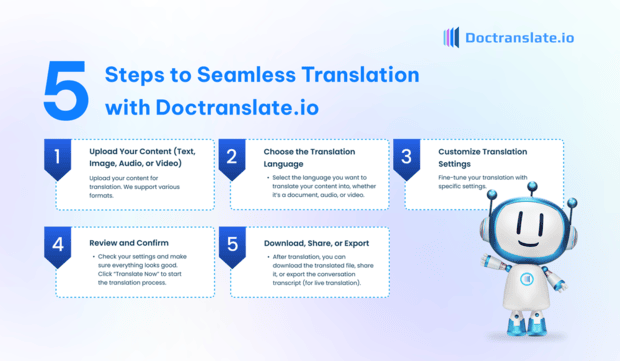Introduction
In today’s interconnected world, sharing academic research across languages is crucial. Translating academic articles from English to Bengali broadens the reach of your work. It allows scholars and researchers in Bengali-speaking regions to access valuable insights. This is essential for fostering global academic collaboration and knowledge dissemination.
However, translating complex academic content requires precision and accuracy. This ensures the integrity and nuances of the research are maintained. Doctranslate.io offers a powerful and user-friendly solution. It simplifies the process of translating academic articles.
With Doctranslate.io, you can overcome language barriers effectively. Our platform is designed to handle the intricacies of academic texts. It provides accurate translations while being easy to use.
This guide will walk you through translating your academic articles. Learn how to seamlessly translate from English to Bengali using Doctranslate.io. Experience a smooth and efficient translation process tailored for academic needs.
Step-by-Step Guide: Translating Academic Articles from English to Bengali with Doctranslate.io
Step 1: Upload Your Content
Begin by uploading your academic article to Doctranslate.io. This is the first step in translating your document. Doctranslate.io supports various file formats commonly used for academic papers.
You can easily upload files such as .docx, .pdf, and .xlsx. Simply click the ‘Upload’ button on the Doctranslate.io website. Alternatively, you can drag and drop your file directly into the upload area for quick access.
To translate your academic document, visit our Translate Document page. This feature is specifically designed for translating documents like academic articles.
Ensure your document is ready for upload in a compatible format. Doctranslate.io is equipped to handle large documents, making it perfect for lengthy academic papers.
Step 2: Choose the Translation Language
After uploading your document, specify the source and target languages. In this case, the source language is English. Select Bengali (Bangladesh) as the target language for your translation.
Doctranslate.io supports a wide array of languages. This ensures you can translate your academic articles into numerous languages beyond Bengali. The language selection process is intuitive and user-friendly.
Choosing the correct languages is crucial for accurate translation. Double-check your selections before proceeding. This ensures that Doctranslate.io correctly processes your academic article for translation.
The language selection step is straightforward within the Doctranslate.io interface. Find the language dropdown menus and make your English to Bengali selections.
Step 3: Customize Your Translation Settings
Enhance your translation by customizing settings on Doctranslate.io. Tailor the translation to meet the specific needs of your academic article. Customization ensures the translated document is precisely aligned with your requirements.
Choose a translation tone that suits academic writing. Options like ‘Serious’ tone maintain formality. Select a domain relevant to your field of study for enhanced accuracy. You can further refine the translation using ‘My Dictionary’ feature.
For document translation, explore advanced customization options. Consider using features like bilingual output if needed. This can be helpful for verifying translation accuracy against the original English text.
To customize your academic article translation, visit our Customize Document Translation settings. Here you can adjust parameters for optimal results.
Step 4: Review and Confirm
Before initiating the translation, review all your chosen settings. Ensure the source and target languages are correct. Double-check any customization options you have selected for your academic article.
This review step is crucial to avoid errors. Making sure everything is set correctly will lead to a smoother translation process. Take a moment to confirm all details within Doctranslate.io.
Once you are satisfied with your settings, proceed to the next step. Click the ‘Translate’ or ‘Translate Now’ button to begin the translation process. Doctranslate.io will then start translating your academic article.
After clicking ‘Translate Now’, the Doctranslate.io system will process your request. The translation time will depend on the length and complexity of your academic article.
Step 5: Download, Share, or Export
Once the translation is complete, your Bengali academic article is ready. Doctranslate.io provides options to download, share, or export the translated document. Choose the option that best fits your needs.
Download the translated file directly to your computer for offline access. Share the translated article with colleagues or collaborators via email. Export options might include different file formats for broader compatibility.
Doctranslate.io ensures easy access to your translated academic work. The platform’s user-friendly interface makes downloading and sharing straightforward. You can quickly disseminate your research in Bengali.
With these flexible output options, Doctranslate.io streamlines the post-translation workflow. Access and share your Bengali academic article effortlessly after translation.

Conclusion
Translating academic articles from English to Bengali is now simple with Doctranslate.io. By following these steps, you gain access to accurate and efficient translations. This process is tailored specifically for academic content, ensuring quality.
Doctranslate.io empowers you to break language barriers in academia. Reach a wider audience by making your research accessible to Bengali speakers. Start translating your academic content today with ease.
Experience the benefits of global academic communication. Use Doctranslate.io to translate your articles and foster international collaboration. Expand the impact of your research worldwide.
Don’t let language barriers limit your academic reach. Visit Doctranslate.io now to begin translating your academic articles. Unlock a world of global readership for your scholarly work.


Leave a Reply